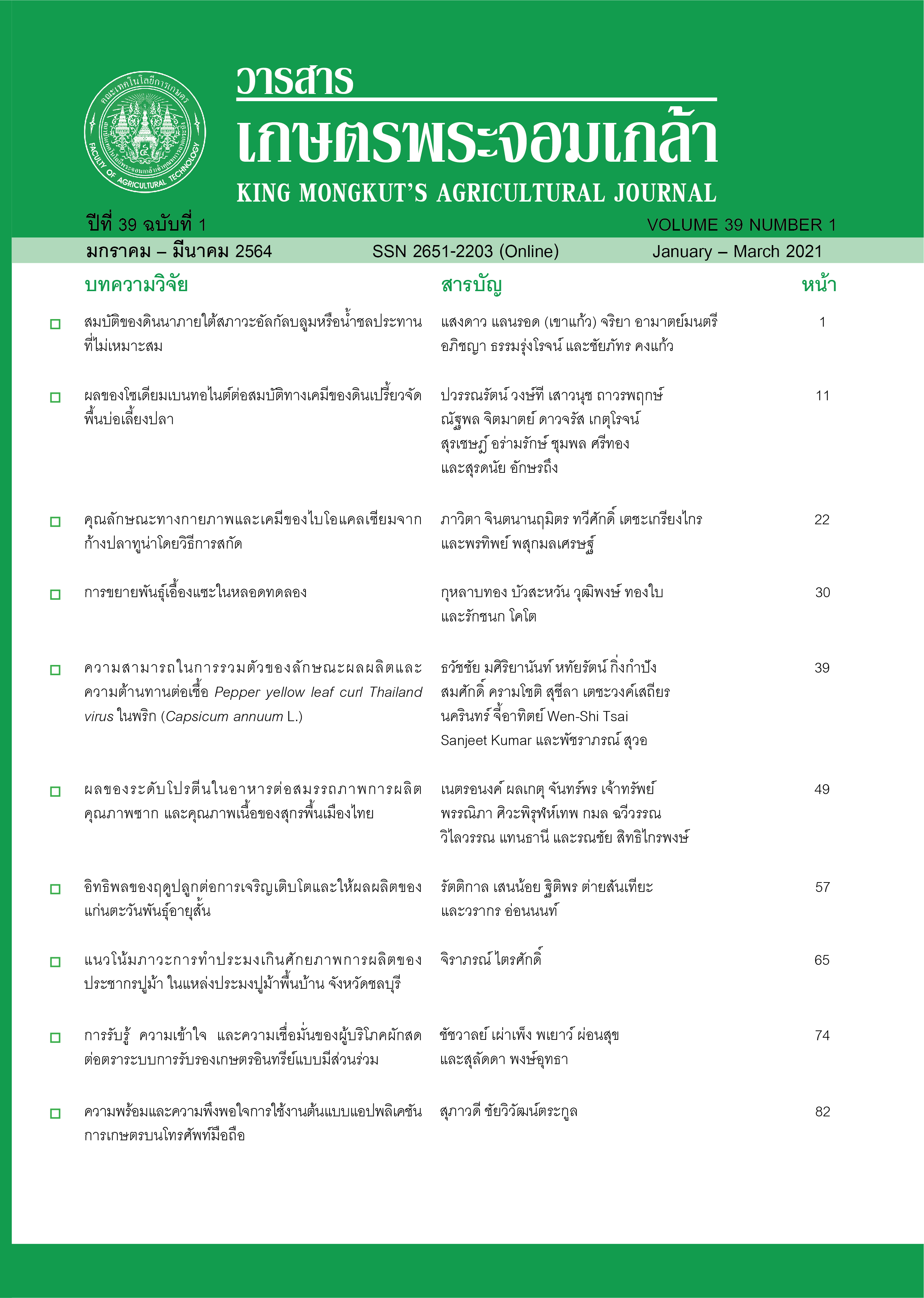Fresh Vegetable Consumer Perceptions; Understanding and Trusting Participatory Guarantee Systems Labelling
Main Article Content
Abstract
Participatory guarantee systems (PGS) have created opportunities for smallholder farmers to access
the organic market, and PGS labeling is used to provide information to consumers. This paper explored
fresh vegetable consumer perceptions, understanding of and trust of PGS labelling. A survey of 608 respondents was conducted in Bangkok and Nakhon Pathom. Descriptive statistics were employed; Mann-Whitney U and Chi-square test were performed. The results showed that 16 percent of consumers were aware of PGS labelling while 21 percent understood it. Consumer trust of PGS labelling was less than consumer trust for organic and good agricultural practices (GAP) from government standard certification and other International Organic Farming Federation standards which are certified by private institutions. Consumers who were aware of and understood PGS labelling had higher trust levels than others. Pesticide safe and organic fresh vegetable consumers were more likely to be aware of and understand PGS labelling, and moreover they had a higher level of trust than others. The results suggest that the government and private sector should develop marketing communication strategies for PGS to improve awareness and understanding of it so that consumers will place more trust in it.
Article Details
King Mongkut's Agricultural Journal
References
ดุสิต อธินุวัฒน์, จินตนา อินทรมงคล, สมชัย วิสารทพงศ์, ปริญญา พรสิริชัยวัฒนา และลักษมี เมตปราณี. 2559. มาตรฐานเกษตรอินทรีย์
แบบมีส่วนร่วมคืออะไร?. Thai Journal of Science and Technology 5(2): 119-134.
ปริชาติ แสงคำเฉลียง และเพียรศักดิ์ ภักดี. 2559. อิทธิพลของการรับรู้และความรู้เกี่ยวกับตรารับรองสินค้าเกษตรที่มีผลต่อการบริโภคสินค้า
เกษตรอินทรีย์ในจังหวัดขอนแก่น. แก่นเกษตร 44(2): 247-256.
Grunert, K. G., Hieke, S., and Wills, J. 2014. Sustainability labels on food products: Consumer motivation, understanding and use. Food Policy 44: 177-189.
Henryks, J., and Pearson, D. 2010. Misreading between the lines: Consumer confusion over organic food labelling.
Australian Journal of Communication 37(3): 73.
Home, R., Bouagnimbeck, H., Ugas, R., Arbenz, M., and Stolze, M. 2017. Participatory guarantee systems: organic certification to empower farmers and strengthen communities. Agroecology and Sustainable Food Systems 41(5): 526-545.
Nelson, E., Tovar, L. G., Gueguen, E., Humphries, S., Landman, K., and Rindermann, R. S. 2016. Participatory guarantee systems and the re-imagining of Mexico’s organic sector. Agriculture and Human Values 33(2): 373-388.
Nelson, E., Tovar, L. G., Rindermann, R. S., and Cruz, M. Á. G. 2010. Participatory organic certification in Mexico: an alternative approach to maintaining the integrity of the organic label. Agriculture and Human Values 27(2): 227-237.
Nuttavuthisit, K., and Thøgersen, J. 2017. The importance of consumer trust for the emergence of a market for green products:
The case of organic food. Journal of Business Ethics 140(2): 323-337.
Roitner-Schobesberger, B., Darnhofer, I., Somsook, S., and Vogl, C. R. 2008. Consumer perceptions of organic foods
in Bangkok, Thailand. Food Policy 33(2): 112-121.
Sangkumchaliang, P., and Huang, W. C. 2012. Consumers’ perceptions and attitudes of organic food products in Northern Thailand. International Food and Agribusiness Management Review 15: 87-102.
Wanwimolruk, S., Duangsuwan, W., Phopin, K., and Boonpangrak, S. 2017. Food safety in Thailand 5: the effect of washing pesticide residues found in cabbages and tomatoes. Journal of Consumer Protection and Food Safety 12(3): 209-221.
Wanwimolruk, S., Phopin, K., Boonpangrak, S., and Prachayasittikul, V. 2016. Food safety in Thailand 4: comparison of pesticide residues found in three commonly consumed vegetables purchased from local markets and supermarkets in Thailand. Peer Journal 4: 1-23.
Wongprawmas, R., Canavari, M., and Waisarayutt, C. 2015. A multi-stakeholder perspective on the adoption of good agricultural practices in the Thai fresh produce industry. British Food Journal 117(9): 2234-2249.


